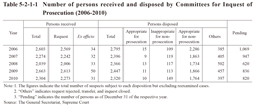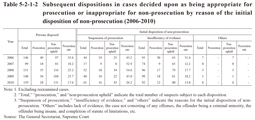Section 1 Involvement of Victims in Criminal Proceedings
1 Appeal system against non-prosecution
The power to prosecute is in principle exclusively granted to public prosecutors. However, even public prosecutors can misjudge a case and decide not to prosecute a suspect who in fact should have been prosecuted. For this reason a system for use in appealing against the disposition of non-prosecution by a public prosecutor was established: a request for review of the case by a Committee for Inquest of Prosecution and an application for the case to be committed to a competent district court for trial (also referred to as the “quasi-prosecution procedure”).
(1) Request for review by a Committee for Inquest of Prosecution
There are currently 165 Committees for Inquest of Prosecution nationwide, with each of them consisting of 11 members who are chosen by lottery from those listed on the electoral register who can then serve a term of six months. Upon receiving a request or ex officio the Committee reviews the non-prosecution disposition concerned made by a public prosecutor and then judges whether the case is “appropriate for prosecution,” “inappropriate for non-prosecution,” or “appropriate for non-prosecution.”
Conventionally decisions made by Committees for Inquest of Prosecution have had no legal binding force, with public prosecutors themselves making the decision on whether prosecution will take place or not after taking into account the decision of the pertinent Committee. The Act on Committee for Inquest of Prosecution (Act No. 147 of 1948) was then amended (by Act No. 62 of 2004), however, and a system where prosecutions could be instituted based on a decision made by a Committee for Inquest of Prosecution under certain conditions was thereby introduced. Within this system, which came into force on May 21, 2009, if a public prosecutor had not prosecuted a case but a Committee for Inquest of Prosecution then decided that the case should have been prosecuted but subsequently a public prosecutor decided not to prosecute the case again or did not prosecute the case within a certain period of time, the Committee for Inquest of Prosecution is required to reexamine the case. If that then results in the Committee deciding that “the case should be prosecuted” (prosecution decision), the court designates a lawyer (designated lawyer) to prosecute the case and to fulfill the prosecution, with the designated lawyer conducting the duties of the public prosecutor in the case pertaining to that decision.
Table 5-2-1-1 shows the number of persons received and disposed by Committees for Inquest of Prosecution (not including reexamined cases) over the last five years. Of persons received in 2010, 2,090 were for penal code offenses. By type of offense, negligence in vehicle driving causing death or injury was the largest in number at 292, followed by fraud at 268, abuse of authority at 267, injury at 243, counterfeit of documents at 221, and theft at 127. 214 persons were received for special act offenses, with Labor Standards Act violations being the largest in number at 38 (all numbers are total numbers) (Source: The General Secretariat, Supreme Court).
Table 5-2-1-1 Number of persons received and disposed by Committees for Inquest of Prosecution (2006-2010)
Table 5-2-1-2 shows the subsequent dispositions made by public prosecutors in cases decided upon as being appropriate for prosecution or inappropriate for non-prosecution by reason of the initial disposition of non-prosecution over the last five years.
Table 5-2-1-2 Subsequent dispositions in cases decided upon as being appropriate for prosecution or inappropriate for non-prosecution by reason of the initial disposition of non-prosecution (2006-2010)
From 1949 (after enforcement of the Act on Committee for Inquest of Prosecution) through to 2010, a total of 157,903 persons were disposed by Committees for Inquest of Prosecution, with 17,603 (11.1%) then involving a decision on them being appropriate for prosecution or inappropriate for non-prosecution. 1,472 were then prosecuted by public prosecutors: 1,313 convicted (459 sentenced to imprisonment and 854 to fine) and 85 found not guilty (including dismissal for judicial bar and dismissal of prosecution) (Source: The General Secretariat, Supreme Court).
The number of persons in cases involving decisions on being appropriate for prosecution by a Committee but with a non-prosecution then being upheld by public prosecutors and a subsequent reexamination by a Committee commenced in 2010 was four, with the Committee reaching the prosecution decision for six persons and not reaching the prosecution decision for one person in the same year (all numbers are total numbers) (Source: The General Secretariat, Supreme Court).
(2) Application to commit cases to a court for trial
Making an application for committing a case to a court for trial is a system that enables anyone that has filed a criminal complaint or accusation regarding an offense committed by public officials, including abuse of authority, etc., to then apply to a competent district court to commit the case for trial if they were dissatisfied with a public prosecutor's non-prosecution disposition. The district court then renders a ruling that the case should go to trial if the request was along with adequate grounds for doing so. Any such ruling results in regarding the case as having been prosecuted, and the court then designates a lawyer to fulfill the prosecution (a “designated lawyer”), who conducts the duties of the public prosecutor in the case concerned.
In 2010 the number of persons newly received by application to commit cases to a court for trial was 468 and the number of persons disposed 479. The decisions to commit the cases to a court for trial were made for one person (Source: Annual Report of Judicial Statistics and The General Secretariat, Supreme Court).
From 1949 (after enforcement of the current Code of Criminal Procedure) through to 2010, the number of persons involving decisions being made to commit the cases to a court for trial, and which were then deemed to have been prosecuted and a final judgment made was 18. Nine of them were convicted (eight sentenced to imprisonment and one to fine) and nine found not guilty (including dismissal for judicial bar).

